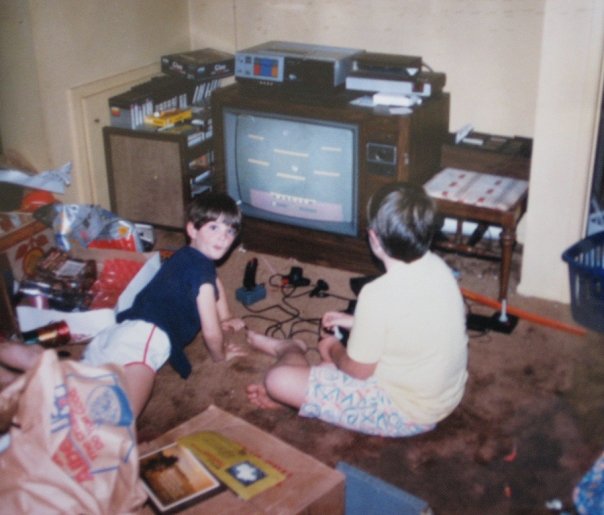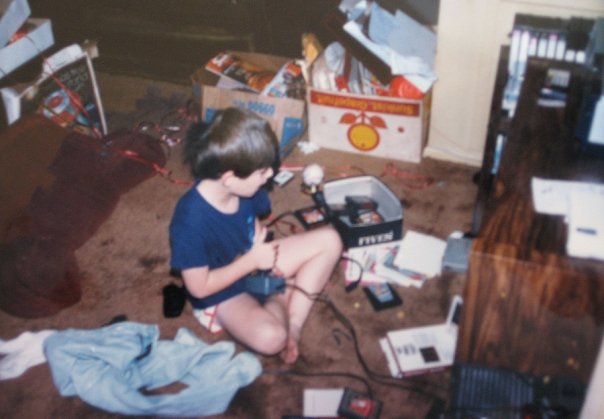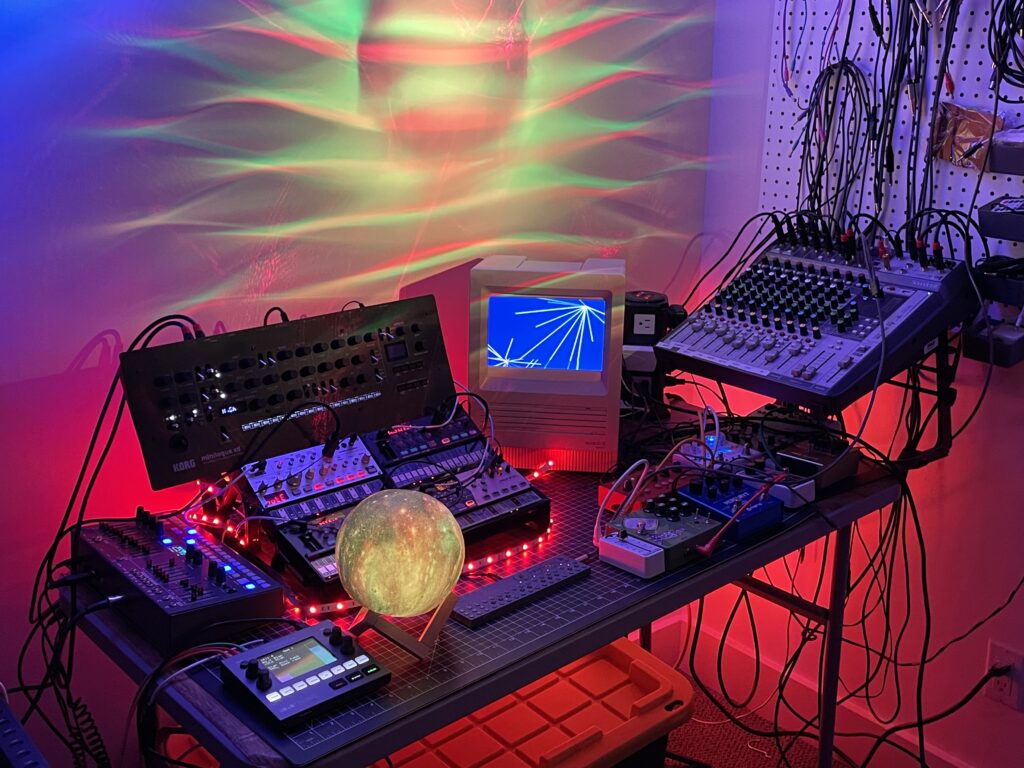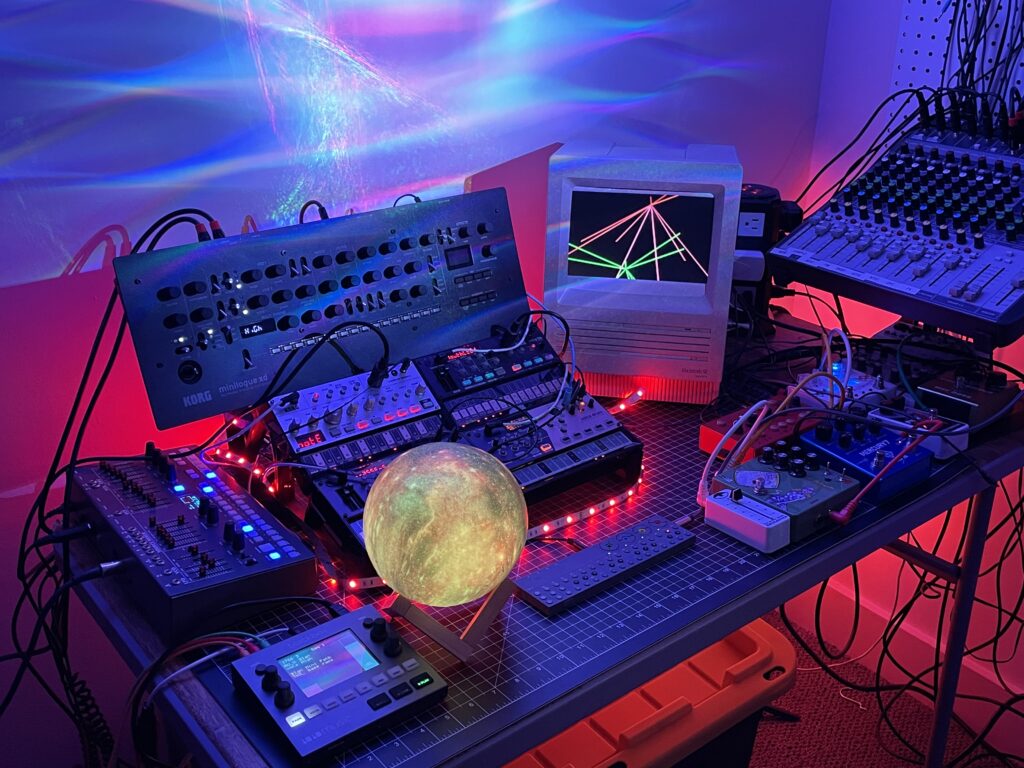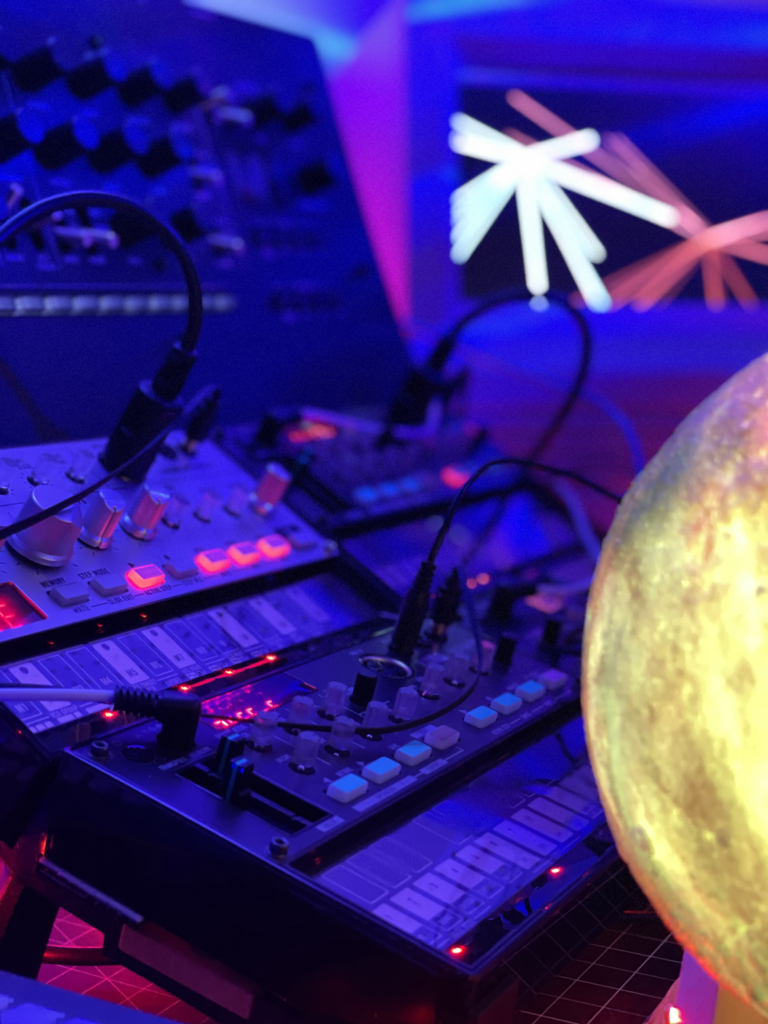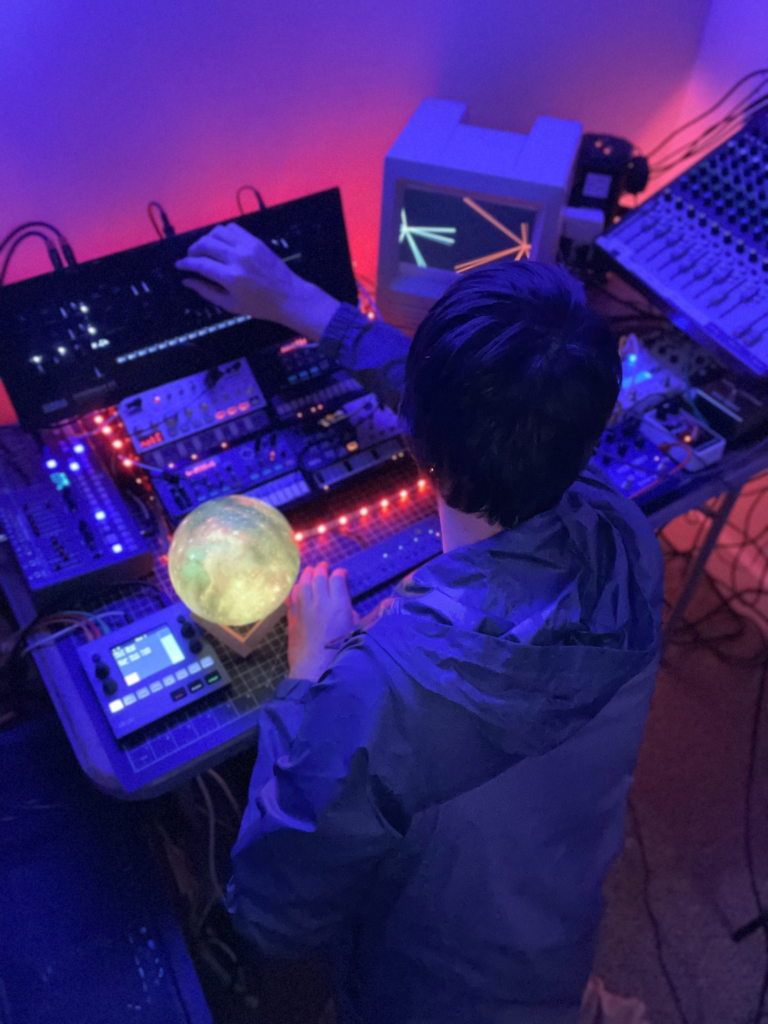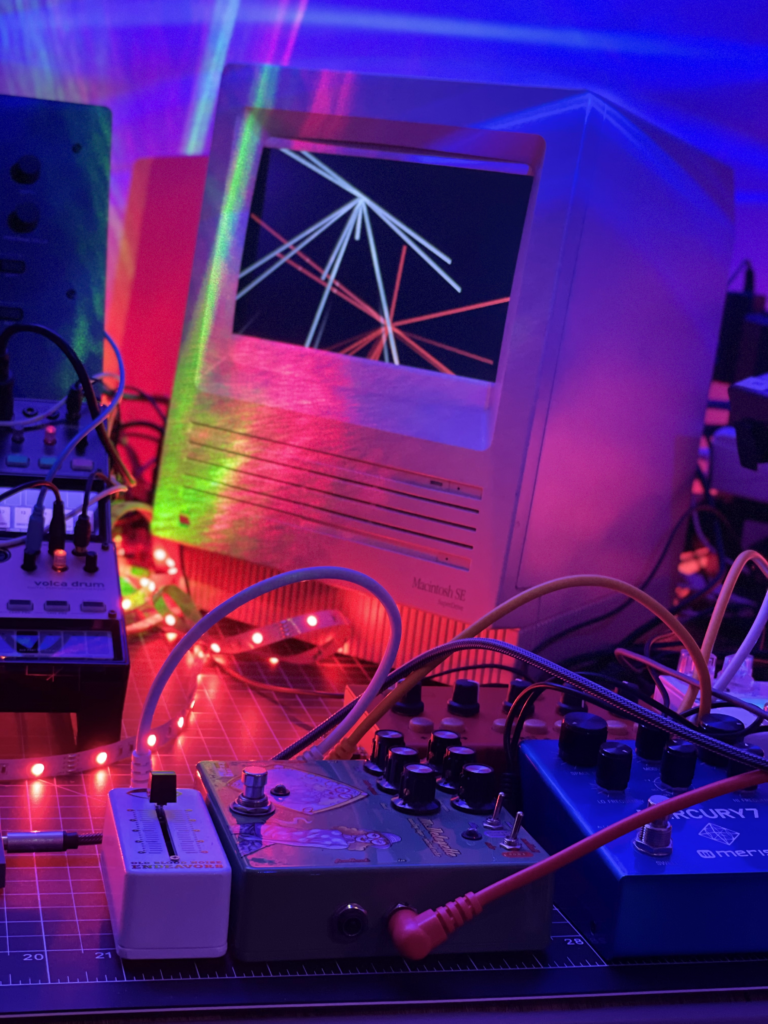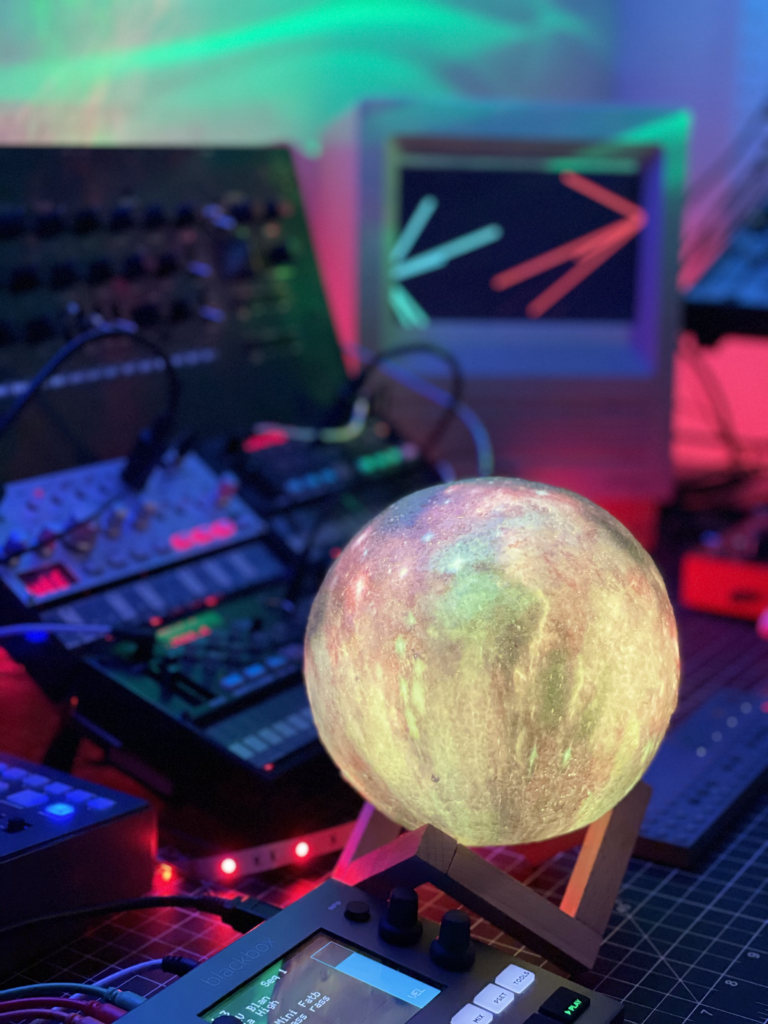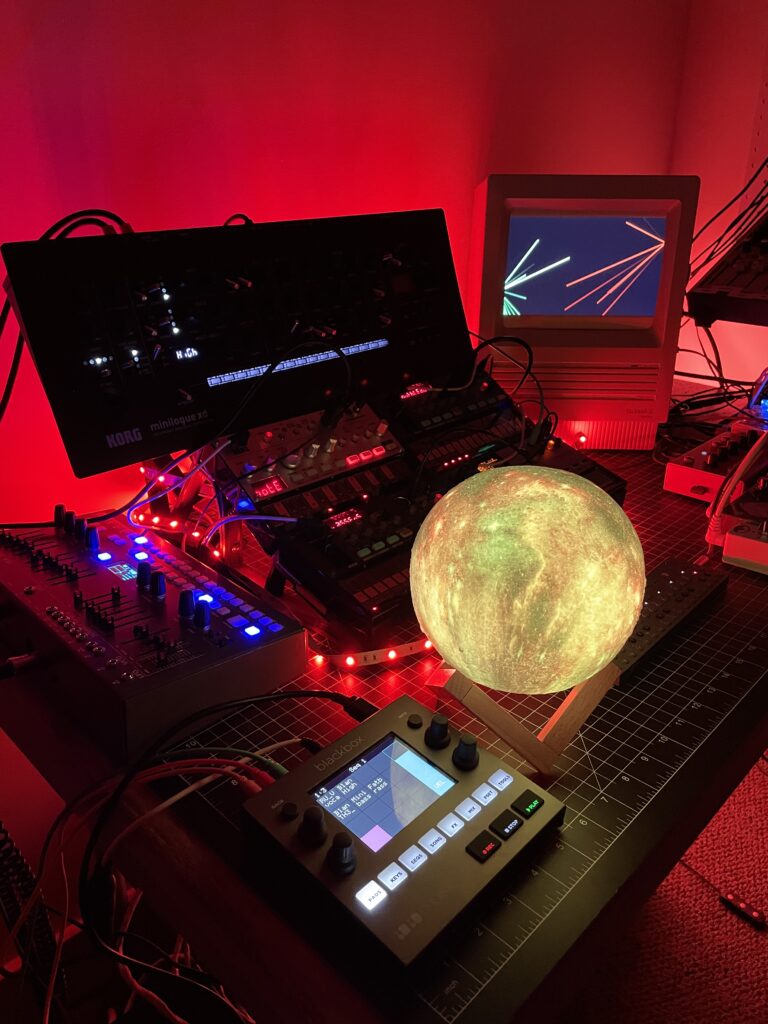Beautiful things happen when music is accompanied by visuals. It allows us to explore an entirely new universe of imagination and creativity, and this is exactly where Blokas wants to take you this time. Meet Tony Grisey, an artist based in the United States of America, who has created an audiovisual sandbox of analog hardware and video. This project is a good example of combining electronic sound with hypnotizing visuals while still leaving space for the audience’s interpretations. So, without further ado, we welcome you to the universe of tony_greesee.
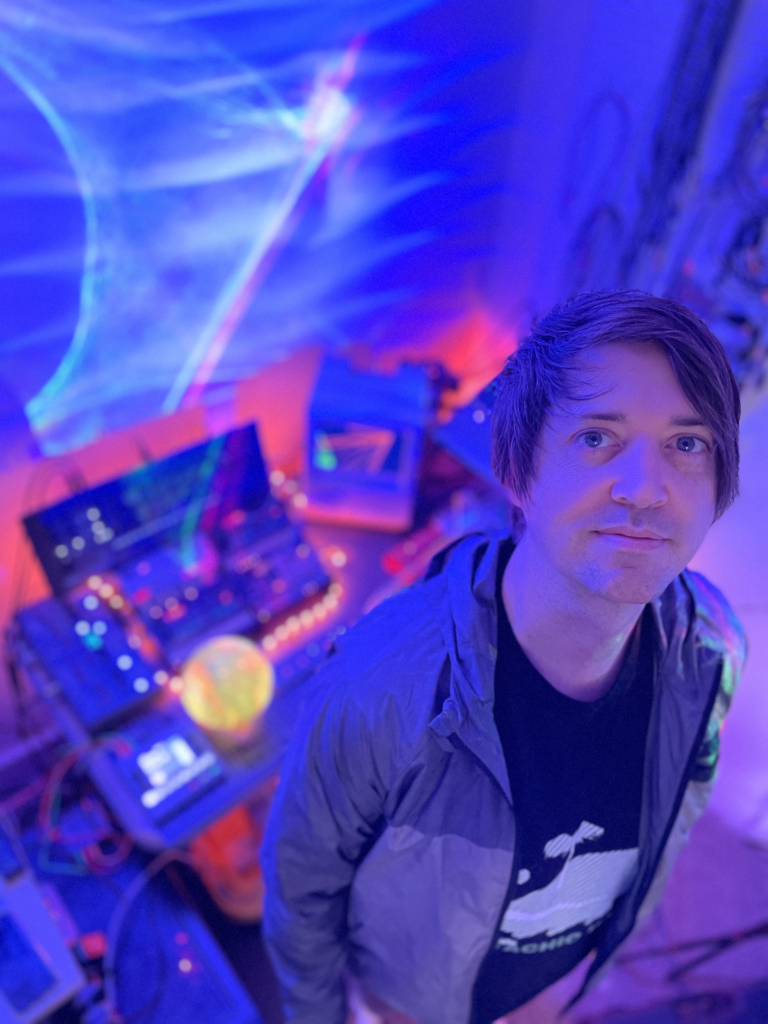
Could you please tell us when and how it all started for you – your relationship with music, your passion for digital art, and video games? Is it something you liked since you were little, or did it come to you quite recently?
Looking back on growing up in an area devoid of culture aka the burbs, there wasn’t much excitement in my day-to-day reality. So, I would often just create my own with endless hours of video games plus trying to figure out how to breakdance by watching every 80’s popping movie I could get my hands on. I was also a huge space and sci-fi movie watching geek and the cinematic scores of John Williams, Vangelis, Hans Zimmer to name a few were all huge influences on me. In fact, every time I create a post for Instagram I head over to the SpaceNews website for inspiration on what the title should be. I watched so much TV growing up that I think cinematic scoring subconsciously drives a lot of the audio snippets I produce.
In terms of my actual music journey I would do what most teens in the 90’s would do which was to overdub mixtapes with a cheap dual cassette boombox. I didn’t have a computer growing up because we couldn’t afford one but eventually I was able to buy one for college. That’s when I started downloading music software like Acid Loops and Propellerheads Rebirth. I loved creating simple repetitive loops that grew and grew and eventually just turned into a wall of sound. During school, I was focused on my 3D animation career so music was always a bit of a luxury and I still think of it as the same way today. I really think formal audio production started around 2015 when a friend told me that he was selling his studio monitors and wanted to know if I had a need for them. I never had a pair of legit studio monitors before and in the back of my mind I knew it was the gateway drug into connecting a few synths into the mix as well. Around 2015 I was also feeling burn-out hard from work binging and long hours in front of a screen. When I started experimenting with the dawless side of audio production it was extremely therapeutic for me to be away from the glowing screens, and I loved that I could connect a few synths together and have a couple friends over to jam for hours. At first, I bet it sounded like a bunch of birds seizing to the average person listening in but it was always exciting where each setting on the synth would take me next and it continues to be.
You have created many unique visual projects, how does your journey from the first idea to the final version look like, and what comes first to you, music or visuals?
I usually try to produce one clip a week and I’ll create the music first generally because I’m fairly comfortable generating a piece of video to fit the tone of the music. I either start with a simple drum loop or a main melody and build it up from there adding in supporting tones. The tone of the music varies daily to how I’m feeling or being able to experiment with a new piece of gear or just generally turning on the gear and going from there. For the most part the entire process takes about three hours from concept to posting on Instagram unless I have a custom video that I need to edit or break apart in a specific way.
The cornerstone and the brain of my setup right now are the OP-Z which allows me to create audio-visualizers inside of the Unity game engine and directly export them to the Teenage Engineering iOS app. The videopaks take a bit of time to generate but that was the plan when I picked up the synth. I think the visuals add more context behind why the musician is invoking a specific mood for whatever he/she is creating. The visuals can set the stage and place the viewer in the reality that the artist creates and that’s usually how I approach most of my personal art projects.
You have worked with some huge brands like PlayStation, Communication Arts, Nike, Coke, and many others. How different is your creative process when working with these big companies and their teams compared to your personal projects?
I was fortunate enough to work at an audiovisual wonderland of a job for the majority of my professional career which allowed me insight into how to create dramatic moments with light and sound so I feel compelled to try to bring that type of production into my personal works where possible. I learned that context and suspenseful timing can be extremely engaging and rewarding for the viewer. The main difference is that not having a deadline in my personal projects gives me the space for more experimentation and allows for happy accidents to occur along the way.
You have also animated visuals for performances of well-known creators like Alyson Stoner, Lil Buck, DJ Shadow and even Kendrick Lamar. How do you create visuals for other musicians in a way that their vision reflects in your art? How is it different from creating visuals for your own music?
When you’re working at an agency the musician isn’t typically reaching out to the art director (me) personally for their vision or style, this is something that is very collaborative and has to grow over the production cycle. I would receive the completed audio-track first about a month away from the performance and then I would break apart the track into components and assign a visual style or a virtual set to each part of the song which would then be sent to the firm that represents the musician. The musician can veto or tweak the vision from there and then the art or digital sets become approved for production. Most of the time the musician has very little (direct) input or request for the background visuals, that gets relayed to me but sometimes during production a dancer or musician has an idea for a prop or a theme that you have to accommodate. End to end, it’s a very iterative and labour-intensive workflow requiring dozens of state of the art computers processing the visuals for the entire show for weeks on end before the live event. Conversely, my process for creating visuals for my music is almost entirely in real-time until I edit the final video prior to posting. I’ve grown to love the real-time aspect of audio and recently most video effects are real-time as well. I use a combo of the OP-Z’s app features such as photomatic and videopak system as well as the critter and guitarri eyesy for the real-time video creation.
Your art is very modern and sometimes even abstract. Where do you find inspiration? What other artists helped you shape your own style and why?
I love stylized colorful 3D art because it allows me to break free of the constraints of trying to make everything look photo-real. It also gives the viewer a chance to apply their own interpretation to what they are seeing and focus on how the visuals interact with the music holistically. One of the videopaks I created called “Exploding Amoeba” works great for this approach, it’s a floating cartoon-like mass that can be programmed to puff up and explode using the OP-Z to control it. The shape is abstract enough to allow the viewer to project their own understanding of what they are experiencing without some preconceived bias of what it should be. I love this type of design where the colors and shapes are approachable but the overall sense is foreign since it’s not anchored in some easily identifiable aspect of modern culture… Some artists that I follow and admire are Daniel Semanas, Dedouze, Kilian Eng, Oritoor, Dirty Robot, and Samuel Jerome Mason mostly because they are pushing the boundary of style and culture.
Could you please tell us more about your setup? What are the most important elements that help you produce this unique electronic music?
I think there has been a general rule of thumb for me as my gear acquisition syndrome was exploding early on. I would keep everything lo-fi and compact and under the $600 range. Initially, the gateway drug was to just jam with friends around four Volcas and iOS apps that we could all sync up. I relied heavily on Retrokits products for syncing other gear together and still use one of their hubs for MIDI-thru and clock sync. As I mentioned previously, I use the OP-Z as the brain and depend on the oplab module(in the op-z) to send out MIDI commands to all of my external gear. The OP-Z has some great ways to control and perform the drums live so I usually program the drums with it and send MIDI commands to my external gear to trigger the rest of the synth voices. I can control up to seven synths externally through the retrokits hub and this works out great because it maxes out my Soundcraft Signature 12 mixer inputs. I tend to use a lot of lo-fi gear so I’ve learned how to craft a pedal chain that can beef up the sound to something more cinematic which is typically the route I like to take. I usually leave one MIDI channel for visuals whether it’s going out to the Blokas Midihub to create a custom MIDI-mapping to control the critter and guitari eyesy or out to the iPad to trigger video clips there. My pandemic project was to get an old Macintosh housing display and use it to display retro-style visuals. Eventually, I want to experiment with a bit of CRT manipulation but I’m trying to keep everything on one table and not overwhelm myself.
As far as we know, you are mostly using Midihub for driving visuals. Do you also use it while creating music? In general, why did you choose to include Midihub in your setup?
I use Midihub right now to generate a custom MIDI map to drive the Eyesy visuals. I am also experimenting with a few patches to embellish some generative MIDI notes which is one of the main selling points I saw in the Loopop video on youtube. I chose to buy the Midihub because working with MIDI can be frustrating and sometimes you just hit a wall with older gear or often you need to perform a specific task with MIDI and don’t have a half-day to waste troubleshooting. I’m used to node-based editing as well so I feel comfortable editing MIDI with a visual editor that you all provide. Thank you, thank you for the visual editor!
We have noticed that you chose Instagram as a platform for your music. Could you please share with us why did you choose this social media over others?
I chose Instagram initially because the dawless community was so supportive and I was consistently learning new ways to approach different synth setups and how to apply audio to visual. It’s mostly about the community and friends I’ve made along the way for me and has been therapeutic during the pandemic. I have tried to create a few communities myself before and I find it to be considerably difficult to sustain. I initially started an AV project called Rhythm Sketch with a bunch of friends that would allow a musician and an artist to collab together. This was going well and was extremely rewarding to curate but eventually became hard to sustain with me continually searching for other artists to generate compelling AV work. I learned a lot from spearheading Rhythm Sketch and used that knowledge to create another community devoted to helping musicians create audiovisual content for their own work using OP-Z called Videolab Creators. This is where I’m trying to give back some of the knowledge that I’ve learned from creating videopaks to the community through tutorials and projects. I’ve had the opportunity to meet and chat with some of my synth hero’s along the way when creating this community. I even received an amazing review from Red Means Recording which blew me away because he basically taught me early on how to use some of the pocket operators through his youtube channel. The other day Cuckoo came into the Discord and asked a few questions on setting up his videopaks, I never know what’s going to happen next but I’m enjoying developing this community to empower others to create real-time visuals with their setups. I’m trying to branch out from the OP-Z to other MIDI-based synths which can use the same system to sync with instruments in real-time using the videopak system. If you’re (using) a Digitakt or OP-1 or Deluge or use a MIDI keyboard then you can utilize this system to generate visuals as well in real-time.
Do you have any exciting future projects or ideas you would like to share with us? Thank you!
I am currently working closer with Teenage Engineering to get more people interested in the videopak system using videolab through the Videolab Creator Portal. I’ll be setting up a few contests as well trying to open the community up to people who don’t own an OP-Z themselves but want to create visuals with their existing MIDI hardware. I am also pushing myself to create some sort of audiovisual album in the future which could also be played live but until then I’m still quite enjoying my current setup. 🙂
Lastly, if you met an artist who would like to start adding visuals to their sound or vice versa, what advice would you give them?
I would say think about your favorite movie or a time where you experienced a show where the visuals were impactful to you. I would then try to figure out what it was that you enjoyed watching or experiencing and try to recreate it and from there you will find your own path. Try to keep things light-weight and real-time so that you’re not bogged down by large hard-drives or laptops.
Follow tony_greesee!
InstagramOfficial website
Videopaks
Videolab Creators
